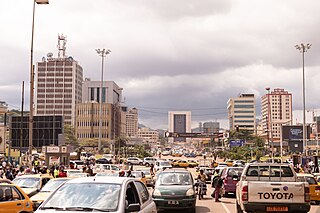
Albert Roger Mooh Miller, commonly known as Roger Milla, is a retired Cameroonian professional footballer who played as a forward. He was one of the first African players to be major stars on the international stage. He played in three World Cups for the Cameroon national team.

The Cameroon national football team, nicknamed in French Les Lions Indomptables, is the national team of Cameroon. It is controlled by the Fédération Camerounaise de Football and has qualified seven times for the FIFA World Cup, more than any other African team. However, the team has only made it once out of the group stage. They were the first African team to reach the quarter-final of the World Cup, in 1990, losing to England in extra time. They have also won five Africa Cup of Nations titles.

The Gabon national football team, nicknamed Les Panthères or Les Brésiliens, is the national team of Gabon and is controlled by the Gabonese Football Federation. They have never qualified for the World Cup, but have qualified seven times for the Africa Cup of Nations.

Pierre Nlend Womé is a Cameroonian retired footballer who played as a defender. A journeyman, Womé was a versatile and skillful left wingback who played for 14 clubs in six countries.

Ahmadou Ahidjo Stadium is a multi-purpose stadium in Yaoundé, Cameroon. It is used mostly for football matches and it also has athletics facilities. It was built in 1972. The stadium has been renovated in 2016 ahead of the African Women Cup of Nations tournament. It has a capacity of 42,500 seats. It is the home stadium of Canon Yaoundé and Tonnerre Yaoundé. The stadium is also known as the home venue of the Cameroonian national football team, who drew the stadium's record attendance of 120,000 in a football match in the 1980s.

The Economic Community of Central African States is an Economic Community of the African Union for promotion of regional economic co-operation in Central Africa. It "aims to achieve collective autonomy, raise the standard of living of its populations and maintain economic stability through harmonious cooperation".
The 1991 Women's African Football Championship was the first staging of the CAF Women's Championship, the women's football championship in Africa (CAF). It determined the CAF's single qualifier for the FIFA Women's World Cup 1991. Nigeria won the tournament, defeating Cameroon in the final.
Samuel Ekemé Ndiba is a Cameroonian former football player who spent ten seasons in Cameroon, one in Major League Soccer, at least two in the USISL, one in the Continental Indoor Soccer League and five in the National Professional Soccer League / Major Indoor Soccer League. He was a member of the Cameroon national football team at the 1994 World Cup.
Louis-Paul M'Fédé was a Cameroonian soccer player who played midfield. He spent his playing career with Cameroonian side Canon Yaounde and Olympic Mvolyé, and Stade Rennais of France and played in the Olympic Football Tournament 1984 in Los Angeles, in the FIFA World Cup with Cameroon in 1990 and 1994. He also took part in 1988, 1990 and 1992 African Nations Cup. He died of a lung infection on 10 June 2013.
Jules Denis Onana is a retired Cameroonian football player. He is the brother of Elie Onana. He played for the club Canon Yaounde, and also took part in the 1990 FIFA World Cup, playing 3 of the 5 matches of the Cameroon national football team. He decided to retire in 2005 after he played in several clubs in Cameroon, France and Indonesia with Pelita Jaya. After retirement, he served as the player agent in Asian countries. He had 56 caps for Cameroon national football team.
Hans Agbo is a Cameroonian football coach and former international player who is the assistant coach of Algerian club MC Oran.

The most popular sport in Cameroon is football. The national team is traditionally one of the strongest teams on the African continent. They have participated in the World Cup 5 times, and in 1990 they reached the quarter-finals. It took extra time before England won the game 3–2. They have also won the African Cup of Nations 4 times as well as winning Olympic gold in Sydney in 2000. Among the most famous players are Roger Milla, Thomas N'Kono and Samuel Eto'o.

Eyong Tarkang Enoh is a Cameroonian football midfielder who plays in the Cypriot First Division for Enosis Neon Paralimni and for the Cameroon national team.
Jacques Bertin Nguemaleu is a Cameroonian football defender who currently plays for TTM Lopburi in the Thai Division 1 League.
The 2009 CEMAC Cup was the sixth edition of the CEMAC Cup, the football championship of Central African nations.
César Madalngué is a Chadian football defender and the member of Chad national football team. He has 14 caps for national team, and he was a part of qualifying campaign for 2010 World Cup.
Jean-Paul Akono is a Cameroonian football coach and former player.
The 2014 CEMAC Cup is the ninth edition of the CEMAC Cup – the football championship of Central African nations.

The 2016 Women Africa Cup of Nations was the 12th edition of the Africa Women Cup of Nations, the biennial international football championship organised by the Confederation of African Football (CAF) for the women's national teams of Africa. The tournament was held in Cameroon between 19 November and 3 December 2016. The initial dates were 8–22 October 2016, but were changed due to weather considerations. A total of eight teams played in the tournament.









